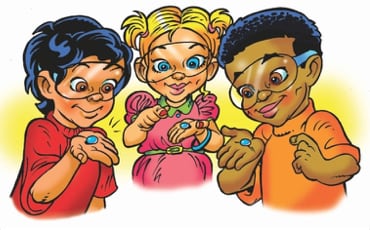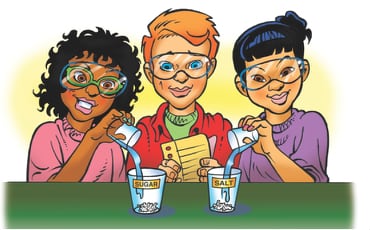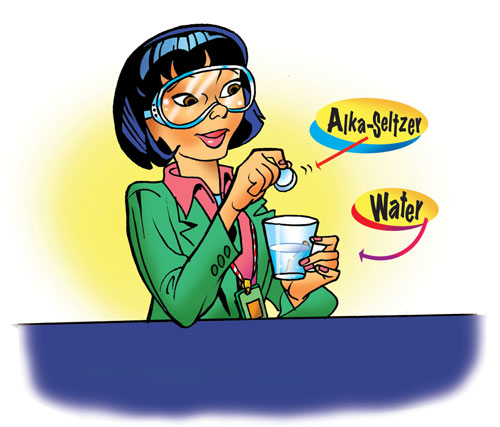Lesson Overview for Teachers
View the video below to see what you and your students will do in this lesson.
Objective
Students will be able to plan and carry out an investigation to compare the property of sinking and floating between different substances. Students will develop an understanding that whether a substance sinks or floats is a property of the substance.
Key Concepts
- Whether a substance floats or sinks is a property of the substance.
- Whether something floats or sinks has to do with how heavy it is and how big it is.
- Things that sink are heavy for their size.
- Things that float are light for their size.
NGSS Alignment
- NGSS 2-PS1-1: Plan and conduct an investigation to describe and classify different kinds of materials by their observable properties.
Summary
- Students will look at several objects made from wax, wood, metal, and rubber and predict and test whether they sink or float.
- Students will be introduced to the idea that whether a substance floats or sinks is a characteristic property of that substance.
Note: The concept of “density” as D=m/v is not addressed directly. Instead, students explore sinking and floating and develop the understanding that things that sink are heavy for their size and things that float are light for their size.
Evaluation
Download the Student Activity Sheet (PDF) and distribute one per student when specified in the activity. The activity sheet will serve as the Evaluate component of the 5-E lesson plan.
Safety
Be sure students wear properly fitting goggles.
Materials for each group
- Pencil
- Popsicle stick
- Birthday candle
- Crayon
- Penny
- Paper clip
- Eraser
- Rubber band
ENGAGE
1. Begin a discussion about sinking and floating by placing a stick and a stone in water.
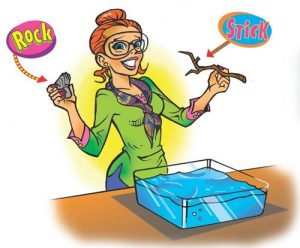
Show students a clear plastic container of water. Hold up a small stick and a stone and ask students which will sink or float. After students make a prediction, place the stick and the stone in the water.
Ask students:
- Do you think other things made out of rocks and stone, like cement and bricks also sink? Why?
Yes, because they are all made out of a material that is similar to the stone. If the stone sinks, the other objects made out of material like stone should also sink. Stone and material like stone has the characteristic property of sinking. - How about the stick? The stick is wood. Do you think most things made of wood, like a Popsicle stick, or wooden building block also float? Why?
Yes, because if wood floats then other things made out of wood should also float. Wood has the characteristic property of floating.
Give each student an Activity Sheet (PDF).
Students will record their observations and answer questions about the activity on the activity sheet.
EXPLORE
Question to Investigate: Do certain materials tend to sink or float in water?
2. Have students predict and then test whether different objects sink or float in water.
Materials for each group
- Pencil
- Popsicle stick
- Birthday candle
- Crayon
- Penny
- Paper clip
- Eraser
- Rubber band
Ask students to use the Activity Sheet to write down which objects they think will sink and which will float.
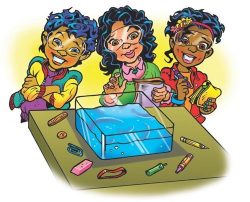
Procedure
- Use the Activity Sheet to say whether you think each object will sink or float.
- Place the objects in the water one at a time to see if they sink or float. Write down your results on the Activity Sheet.
Expected results:
Objects that sink:
Penny
Paper clip
Eraser
Rubber band
Objects that float:
Candle
Crayon
Pencil
Popsicle stick
Ask students
- What do the penny and paper clip have in common?
They are both made out of metal. A characteristic property of metal is that it sinks. - What do the eraser and rubber band have in common?
They are both made out of rubber. A characteristic property of rubber is that it sinks. - What do the candle and crayon have in common?
They are both made out of wax. A characteristic property of wax is that it floats. - What do the pencil and Popsicle stick have in common?
They are both made out of wood. A characteristic property of wood is that it floats.
EXPLAIN
3. Show an animation to help explain that floating or sinking is a characteristic of a substance regardless of how much it weighs.
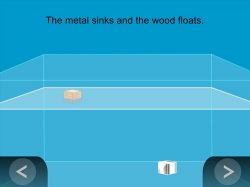
Show the animation Sink and Float.
Explain that if a block of metal and a block of wood are the same size, the metal will be heavier. Metal also sinks in water and wood floats. But what if a piece of wood is bigger and weighs as much as the metal? The bigger piece of wood still floats. What if the wood is even bigger and weighs more than the metal? The wood still floats! Floating is a property of wood no matter how big it is and how much it weighs.
If a rubber eraser and a wax candle are the same size and shape, the eraser will weigh more. The eraser will sink and the candle will float. But what if a smaller piece of eraser weighs the same as the wax candle? The piece of eraser will still sink. What if the eraser is even smaller and weighs less than the candle? The eraser still sinks! Sinking is a property of eraser rubber no matter how small it is and how little it weighs.
EXTEND
4. Demonstrate to students that liquids can float or sink in water.
Tell students that liquids can also float or sink in water. Some liquids have the property that they sink in water. Other liquids have the property that they float in water.
Materials for the demonstration
- Water
- Corn syrup
- Mineral or vegetable oil
- Food coloring
- 4 clear plastic cups
- Popsicle stick or plastic spoon
Teacher preparation
- Add about 2 tablespoons of water to a clear plastic cup.
- Add 1 drop of blue food coloring to the water and swirl to mix.
- Add 2 tablespoons of corn syrup to a separate clear plastic cup.
- Add about 2 tablespoons of vegetable oil to a separate cup.
Procedure
- Pour the colored water into a clear plastic cup and show it to students.
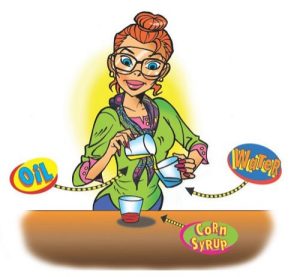
Ask students:
- Do you think the oil will float, sink, or mix into the water?
- While holding up the cup with the water, slowly pour the oil down the inside surface of the cup.
Expected results
The oil floats on the water.
- Show students that you have corn syrup.
Ask students:
- Where do you think the corn syrup will end up?
- While holding up the cup with the water and oil, slowly pour the corn syrup down the inside surface of the cup.
Recommended book list:
- Floating and Sinking by Karen Bryant-Mole
- Floating and Sinking by Ellen S. Niz
- Does it Sink or Float by Susan Hughes
- Things That Float and Things That Don’t by David Adler
- What Floats in a Moat by Lynne Berry (rhyming text)

